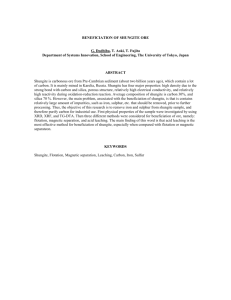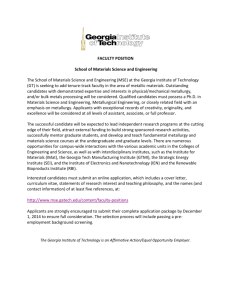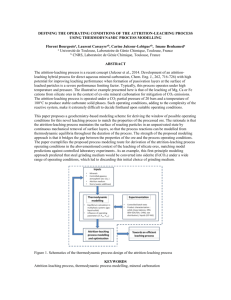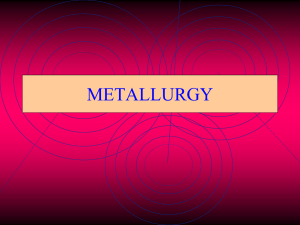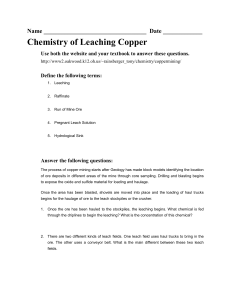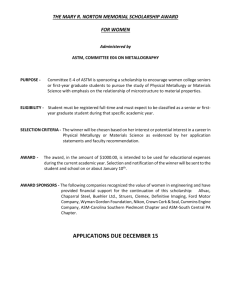Mineral Resources and Ore-testing
advertisement
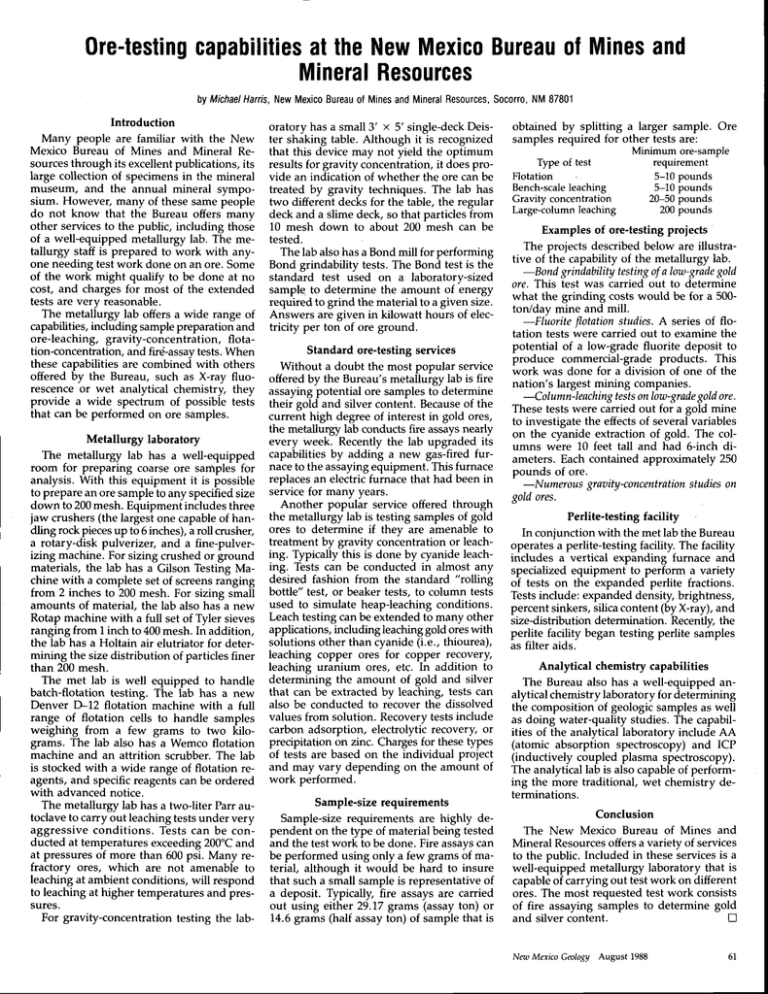
and
Ore-testing
Bureau
capabilities
attheNewMexico
of Mines
Mineral
Resources
NM87801
byMichael
Harrs,NewMexico
Bureau
Resources,
Socono,
of Mines
andMineral
Introduction
Many people are familiar with the New
Mexico Bureau of Mines and Mineral Resourcesthrough its excellentpublications, its
large collection of specimensin the mineral
museum, and the annual mineral symposium. However, many of these same people
do not know that the Bureau offers many
other servicesto the public, including thos-e
of a well-equipped metallurgy lab. The metallurgy staff is prepared to work with anyone needingtest work done on an ore. Some
of the work might qualify to be done at no
cost, and charges for most of the extended
tests are very reasonable.
The metallurgy lab offers a wide range of
capabilities,including samplepreparationand
ore-leaching, gravity-concentration, flotation-concentration,and firel-assay
tests.When
these capabilities are combined with others
offered by the Bureau, such as X-ray fluorescence or wet analytical chemistry, they
provide a wide spectrum of possible tests
that can be performed on ore samples.
Metallurgy laboratory
The metallurgy lab has a well-equipped
room for preparing coarse ore samples for
analysis. With this equipment it is possible
to prepare an ore sample to any specifiedsize
down to 200mesh. Equipment includes three
jaw crushers (the largest one capableof handling rock piecesup to 5 inches),a roll crusher,
a rotary-disk pulverizer, and a fine-pulverizing machine. For sizing crushed or ground
materials, the lab has a Gilson Testing Machine with a complete set of screensranging
from 2 inches to 200 mesh. For sizing small
amounts of material, the lab also has a new
Rotap machine with a full set of Tyler sieves
ranging from L inch to 400mesh. In addition,
the lab has a Holtain air elutriator for determining the size dishibution of particles finer
than 200 mesh.
The met lab is well equipped to handle
batch-flotation testing. The Iab has a new
Denver D-12 flotation machine with a full
range of flotation cells to handle samples
weighihg from a few grams to two kilograms. The lab also has a Wemco flotation
machine and an attrition scrubber. The lab
is stocked with a wide range of flotation reagents, and specificreagentscan be ordered
with advanced notice.
The metallurgy lab has a two-liter Parr autoclave to carry out leaching testsunder very
aggressiveconditions. Tests can be conducted at temperaturesexceeding200"Cand
at pressuresof more than 500psi. Many refractory ores, which are not amenable to
leaching at ambient conditions, will respond
to leaching at higher temperaturesand pressures.
For gravity-concentration testing the lab-
oratory has a small 3' x 5' single-deckDeis- obtained by splitting a larger sample. Ore
ter shaking table. Although it is recognized samples required for other tests are:
Minimum ore-sample
that this device may not yield the optimum
requirement
Typeof test
results for gravity concentration, it does proFlotation
5-10pounds
vide an indication of whether the ore can be
Bench-scale
leaching
5-10pounds
treated by gravity techniques. The lab has
20-50pounds
Gravityconcentration
two different decks for the table, the regular
leaching
Large-column
200pounds
deck and a Slimedeck, so that particles from
be
L0 mesh down to about 200 mesh can
Examples of ore-testing projects
tested.
The projects described below are illustraThe lab also has a Bond mill for performing
tive of the capability of the metallurgy lab.
Bond grindability tests.The Bond test is the
-Bond grindabilitytestingof a low-gradegold
test
standard
used on a laboratory-sized
ore.
This test was carried out to determine
sample to determine the amount of energy
what the grinding costs would be for a 500required to grind the material to a given size.
mine and mill.
Answers are given in kilowatt hours of elec- torVday
-Fluorite flotation studies.A series of flotricity per ton of ore ground.
tation tests were carried out to examine the
potential of a low-grade fluorite deposit to
Standard ore-testing services
produce commercial-grade products. This
Without a doubt the most popular service work was done for a division of one of the
offered by the Bureau's metallurgy lab is fire
nation's largestmining companies.
assayingpotential ore samples to determine
--{.olumn-Ieaching
testson low-grade
goldore.
their gold and silver content.Becauseof the
These tests were carried out for a gold mine
current high degree of interest in gold ores,
to investigate the effectsof severalvariables
the metallurgy lab conducts fire assaysnearly
on the cyanide extraction of gold. The colevery week. Recently the lab upgraded its
umns were 10 feet tall and had 6-inch dicapabilities by adding a new gas-fired furameters. Each contained approximately 250
naceto the assayingequipment. This furnace
pounds of ore.
replacesan electric furnace that had been in
-N umerousgraoity-concentration
studieson
servicefor manv vears.
golil ores.
Another popirtir service offered through
the metallurgy lab is testing samplesof gold
Perlite-testing facility
ores to determine if they are amenable to
In conjunction with the met lab the Bureau
treatment by gravity concentration or leach- operatesa perlite-testing facility. The facility
ing. Typically this is done by cyanide leach- includes a vertical expanding furnace and
ing. Testscan be conducted in almost any specialized equipment to perform a variety
desired fashion from the standard "rolling
of tests on the expanded perlite fractions.
bottle" test, or beaker tests, to column tests Testsinclude: expanded density, brightness,
used to simulate heap{eaching conditions.
percent sinkers, silicacontent (by X-ray), and
Leach testing can be extended to many other
size-distribution determination. Recently,the
applications,including leachinggold oreswith
perlite facility began testing perlite sarirples
solutionsother than cyanide(i.e., thiourea), as filter aids.
leaching copper ores for copper recovert
Analytical chemistry capabilities
leaching uranium ores, etc. In addition to
determining the amount of gold and silver
The Bureau also has a well-equipped anthat can be extracted by leaching, tests can
alytical chemistry laboratory for determining
also be conducted to recover the dissolved the composition of geologic samplesas well
values from solution. Recoverytests include
as doing water-quality studies. The capabilcarbon adsorption, electrolytic recovery, or
ities of the analytical laboratory include AA
precipitation on zinc. Chargesfor thesetypes (atomic absorption spectroscopy) and ICP
of tests are based on the individual project
(inductively coupled plasma spectroscopy).
and may vary depending on the amount of
The analytical lab is also capableof performwork performed.
ing the more traditional, wet chemistry determinations.
Sample-size requirements
Conclusion
Sample-size requirements are highly dependent on the type of material being tested
The New Mexico Bureau of Mines and
and the testwork to be done. Fire assayscan Mineral Resourcesoffers a variety of services
be performed using only a few grams of mato the public. Included in these servicesis a
terial, although it would be hard to insure
well-equipped metallurgy laboratory that is
that such a small sample is representativeof
capableof carryrng out test work on different
a deposit. Typically, fire assaysare carried
ores. The most requestedtest work consists
out using either 29.17 grams (assayton) or
of fire assaying samples to determine gold
L4.5grams (half assayton) of samplethat is
tr
and silver content.
NartMexicoGeolo3yAugust1988
